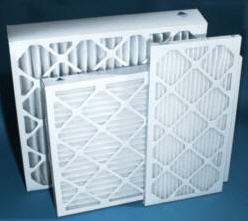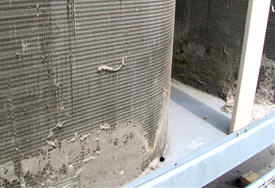HVAC Practices
 Indoor Temperature Control – the AUTOMATIC control of indoor temperature is the single most effective HVAC Practice. Although controls for large, complicated systems can be expensive and may therefore be considered a Measure, making sure the controls are working, adjusted properly, and not tampered with is considered a Practice.
Indoor Temperature Control – the AUTOMATIC control of indoor temperature is the single most effective HVAC Practice. Although controls for large, complicated systems can be expensive and may therefore be considered a Measure, making sure the controls are working, adjusted properly, and not tampered with is considered a Practice.
Dead band thermostats – or thermostats that cannot automatically switch between heating and cooling modes should be used for most spaces. A ‘dead band’ is a range of temperature where neither heating nor cooling is being performed. For example, the heat may be set to come on when the temperature is below 70F. The Cooling may be set to come when the temperature is above 76F. The ‘band’ of 71 – 75F is a ‘dead band’.
Simultaneous heating and cooling of the same space must be avoided – this can happen when multiple, small/individual HVAC units have individual controls, yet serve a common space. For example, an office with an open floor plan, restaurant seating areas, large lobbies, etc., may have one HVAC unit in the heating mode and one in the cooling mode. The units are ‘fighting’ each other.
Thermostat Lock Boxes – public thermostats should be located in a lock box or otherwise tamper-resistant area. Limit who has access to the controls, if a central energy management system is not used. New thermostats have security features that do not require a lock box and give limited control to non-authorized users.
Unoccupied Setbacks/up – the single most cost effective Practice is unoccupied temperature control. Programmable thermostats must be used to achieve consistent results. Some new thermostats offer a ‘light sensor’ that automatically puts the HVAC system in unoccupied mode when the lights go off. This can be very useful for installations that have irregular schedules.
Wireless Thermostats – new wireless technology makes it possible to install thermostats in areas previously inaccessible.
System Tune-up – natural gas is a clean-burning fuel that doesn’t require much in the way of system cleaning. About all that needs to be done is to keep the air supply path to the burners relatively clean and unobstructed. Units that are located in dirty or dusty areas will need a little more attention. Should the air supply become restricted, it’s possible to produce soot which can cause problems with the heat exchanger. Unit heaters or other types of open-air systems located in industrial areas can be subject to more types of contamination from whatever may be in the air.
Units should be cleaned to keep combustion air pathways clean. If the heat exchanger becomes coated with soot or other kinds of debris, then it must be cleaned in a manner that is going to take care of the problem and hopefully avoid future recontamination.
Most atmospheric (non-fan-powered burners) systems have some sort of manual air control. A burner that gets too much air wastes fuel by heating more air/exhaust than is necessary for good combustion. A burner that is starved for air has incomplete combustion and can produce soot and carbon monoxide. On small systems, air controls are generally set ‘by eye’ (checking for a steady blue flame). A better way is to us a combustion analyzer. Either way, once properly set, they generally do not require adjustment beyond keeping them clean.
Larger systems and boilers that have variable fire burners should also have variable air control dampers. Newer units with fan-forced induced combustion are less sensitive to air adjustments. These units will have a vacuum safety switch to confirm that the burner is getting enough combustion air. If the air supply becomes plugged the burner will not operate.
 Filter Maintenance – regardless of the size of system, air filter maintenance is critical to proper system performance. When filters become plugged, the distribution fan cannot move as much air which affects indoor comfort and the heat exchanger looses efficiency allowing higher exhaust temperatures – more heat wasted up the flue. Filters are critical in both the heating and cooling modes.
Filter Maintenance – regardless of the size of system, air filter maintenance is critical to proper system performance. When filters become plugged, the distribution fan cannot move as much air which affects indoor comfort and the heat exchanger looses efficiency allowing higher exhaust temperatures – more heat wasted up the flue. Filters are critical in both the heating and cooling modes.
There are many types of filters in many price ranges. The higher cost filters will generally have a higher surface area (more pleats) so it can last longer and filter out smaller particulates. Regardless of the filter type, it must be maintained. Filters should NEVER be removed, as then heat exchangers can become plugged, which are much more difficult to clean than filters.
Boiler Water – it is especially critical to keep boiler water treated and clean. If scale from improperly treated water is allowed to accumulate on/in the tubes of a boiler, substantial reductions in heat transfer result. Scale (lime, rust, etc.) is a very good insulator. For more information see Boilers
Ventilation System – shut off all exterior ventilation during non-occupied periods and eliminate “excess” ventilation during occupied periods. This may not be possible in all situations, but most buildings do not require ventilation when unoccupied. In cases where facility use has changed, it’s possible that there may be too much ventilation during occupied periods.
The balance between indoor air quality and energy management is affected by energy costs, employee attitudes, codes and what’s going on in the space. A recommendation to reduce ventilation air during occupied periods must always be approached with extreme caution.
For more information see Ventilation Systems

 Air Conditioner Condenser Coils – keep outdoor air conditioner condenser coils free of debris, such as leaves, dirt, cotton wood, etc. Also, be sure coils are located in an area of good air flow and where possible, out of direct contact with sunshine. Users often desire to shield outside HVAC systems from view. If a solid privacy fence is installed in such a way that air flow is blocked, air conditioner performance will suffer. The efficiency of an air conditioner is directly related to the outdoor temperature. When air flow is blocked by dirt, fences, etc., the effective temperature goes up and the efficiency (and capacity) goes down.
Air Conditioner Condenser Coils – keep outdoor air conditioner condenser coils free of debris, such as leaves, dirt, cotton wood, etc. Also, be sure coils are located in an area of good air flow and where possible, out of direct contact with sunshine. Users often desire to shield outside HVAC systems from view. If a solid privacy fence is installed in such a way that air flow is blocked, air conditioner performance will suffer. The efficiency of an air conditioner is directly related to the outdoor temperature. When air flow is blocked by dirt, fences, etc., the effective temperature goes up and the efficiency (and capacity) goes down.
Source: Text Bob Fegan 1/2009;
© 2008 Energy Solutions Center400 N. Capitol Street NWWashington, DC 20001 All rights reserved. Legal Contact our webmaster
